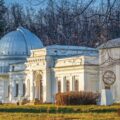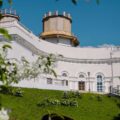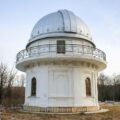- Астрономическая обсерватория имени В.П.Энгельгардта/Engelhardt Astronomical Observatory © Kazan Federal University
- Центральная башня обсерватории — место расположения телескопа-рефрактора/The observatory’s central tower, where the refractor telescope is located © Kazan Federal University
- © Kazan Federal University
- © Kazan Federal University
On September 18, at the 45th session of the UNESCO World Heritage Committee, the Astronomical Observatories of the Kazan Federal University were included in the UNESCO World Heritage List by unanimous decision.
The inclusion of Kazan observatories in the UNESCO World Heritage List became a symbolic event, because the Astronomy and World Heritage initiative of the UNESCO World Heritage Center for the identification and preservation of astronomical heritage monuments was first announced in 2003, twenty years ago. The Center aimed to preserve unique monuments of astronomical heritage and to establish a link between Science and Culture.
Specialists from Kazan Federal University prepared the documents for several years. In 2020, the Astronomical Observatories of Kazan Federal University were included in the Tentative List of World Heritage Sites. And in 2022, five volumes of documents were handed over to the UNESCO World Heritage Center, including a nomination dossier, a draft management plan, and visual materials.
The site includes two observatories. The first one was built in 1837 as part of the Kazan University based on the Department of Astronomy founded by the Austrian astronomer Joseph Littrow. The building has a semi-circular facade with halls along the curve. Now all of them act as classrooms, while in mid-19th century, the main hall was used for receiving visitors and storing portable tools, and the eastern and western halls were for observing the sky. The second observatory, located 20 kilometers from Kazan, was opened in 1901 and bears the name of the famous astronomer and public figure Vasily Engelhardt. He donated the equipment from his private observatory in Dresden to Kazan University when he retired from academia. Engelhardt gifted two thousand books from his library as well as various tools and optical devices. The Engelhardt Observatory is an entire complex of buildings. Next to the main building with the astronomical tower and the meridian circle pavilion, there is an elegant two-story administrative building in Neoclassical style that was used as the living quarters for the staff in the early 20th century. The complex also features the heliometer pavilion, a library and a chapel that contains the graves of Dmitry Dubyago, the first director and founder of the Engelhardt Observatory, and Vasily Engelhardt, reburied in 2014 from Germany.
Both objects are unique examples of a specific type of compact university observatories that were built in the style of Russian classicism and reflect an important stage in the establishment and development of architectural, landscape and technological complexes characteristic of the 19th century astronomy, when optical visual observations were the main way to study stars and planets.
By the time of their inclusion in the World Heritage List, the observatory has preserved not only its architectural integrity, but its original function as a research and educational facility. The objects is still being used for their intended purpose and make a significant contribution to the development of global astronomical science and training of young specialists in the field of space exploration. The observatory partners with the National Astronomical Observatory of Japan, the Shanghai Astronomical Observatory (China), the Abastumani Observatory (Georgia), the Czech Technical University, the Sternberg Astronomical Institute of Moscow State University, the Space Research Institute and the Institute of Astronomy of the Russian Academy of Sciences. The achievements of the observatory staff are mentioned in textbooks and monographs on astronomical disciplines.
The observatories of Kazan University became the 32nd site representing Russia, 4th World Heritage Site in Tatarstan and the 1184th entry to the World Heritage List overall. The List currently has few sites that have both architectural and scientific value, and this makes the inclusion of Kazan observatories in the world heritage especially significant.
Tatiana Borisova




